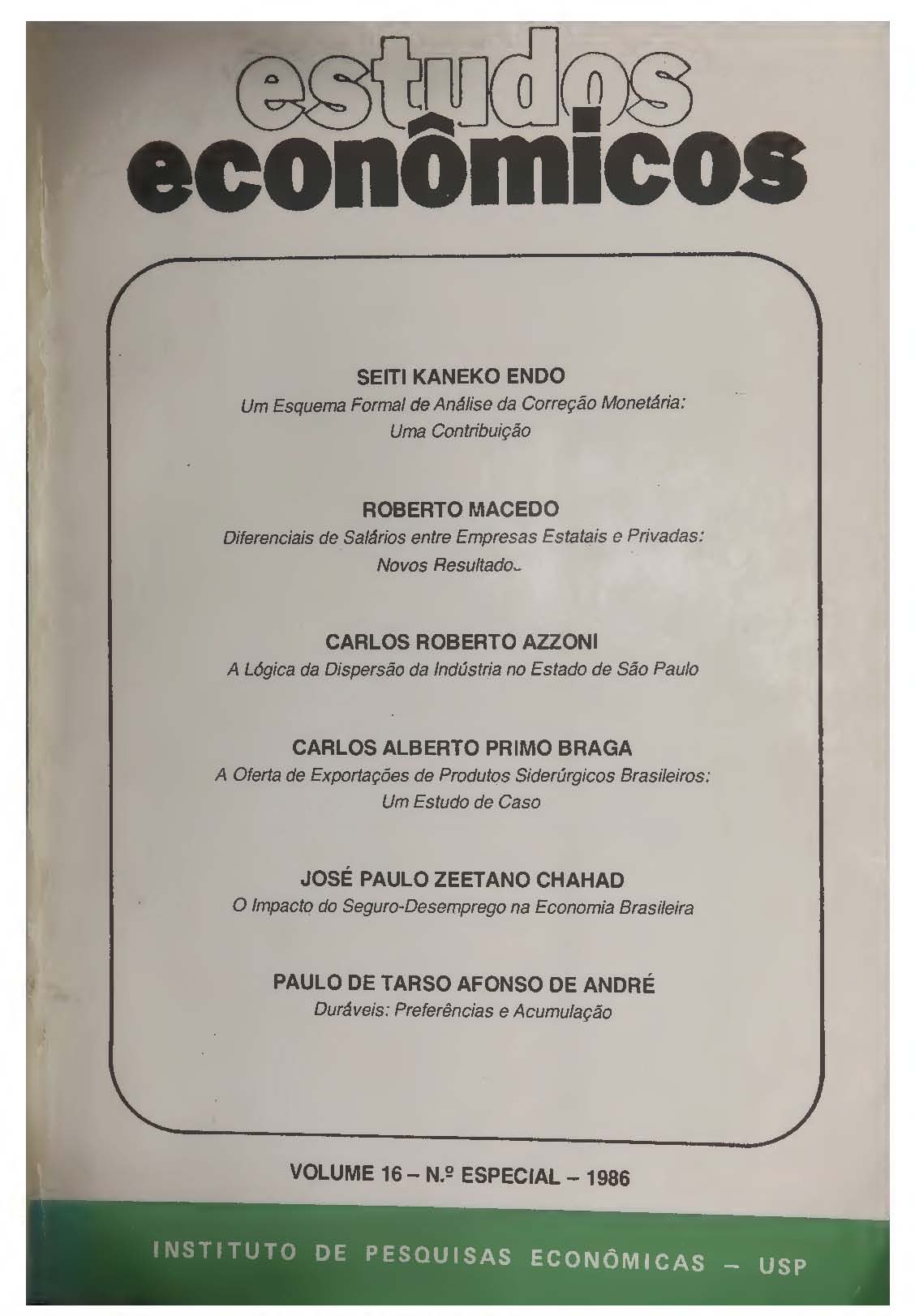Duráveis: preferências e acumulação
DOI:
https://doi.org/10.11606/1980-535716n6ptaaAbstract
Consumer choice among durables cannot be satisfactorily accommodated by models directly derived from the conventional, deterministic model. This study proposes an axiomatic and probabilistic framework for modelling consumer choice preferences among durables in the market and discusses its theoretical properties. The related qualitative econometric model is specified, the empirically testable hypotheses implied by the proposed framework are discussed, as are the empirical properties of the measures relevant to behavior in the market for durables. For the empirical test of the model, Brazilian (state of Sao Paulo) cross-sectional household data (ENDEF survey) is used for the set of four durables: refrigerator, blender, sewing machine and television. The estimation results strongly support the theory. The implications to Brazilian (Sao Paulo) consumer behavior in the market for durables are derived and discussed. Among others, the results for Sao Paulo consumers sharply contradict the notion that preferences for durables revealed in the market merely reproduce those of the high income consumer.
Downloads
References
ANDRE, P.T.A. The ENDEF survey. In: SCOTT, C; ANDRE, P.T.A. & CHANDER, R. Conducting surveys in developing countries: practical problems and experience in Brazil, Malaysia and the Phillippines. Washington, Living Standards Measurement
Study Working Paper Series, 5, Development Research Center, World Bank, 1980.
BLOCK, H.D. & MARSCHAK. J. Random orderings and stochastic theories of response. In: OLKIN I. et al. (eds.).
Contributions to probability and statistics: essays in honor of Harold Hotelling. Stanford, Stanford University Press, 1960, p. 97-132.
FARREL, MJ. The demand for motorcars in the United States. Journal of the Royal Statistical Society, series A, 777; 171- 201,1954.
HALLDIN, C. The choice axiom, revealed preference and the theory of demand. Theory and Decision, 5: 139-160, 1974.
LUCE, R.D. Individual choice behavior: a theoretical analysis. New York, John Wiley, 1959.
LUCE, R.D. The choice axiom after twenty years. Journal of Mathematical Psychology, 15: 215-233, 1977.
LUCE, R.D. et al. Preference, utility and subjective probability. In: R.D. Luce et al: (eds.). Handbook of mathematical psychology. New York, John Wiley, 1965, V. Ill, p. 249-410.
MARSCHAK, J. Norms and habits of decision making under certainty. In: DUNLAP & ASSOCIATES, INC. Mathematical models of human behavior: proceedings of a symposium. Stamford, Conn., 1955, p. 45-53.
MARSCHAK, J. Binary choice constraints and random utility indicators. In: ARROW, K.J. Mathematical methods in the social sciences. Stanford, Stanford University Press, 1960, p. 312-329.
MARSCHAK, J. et al. Stochastic models of choice behavior. Behavioral Science, 5(1): 41-55,1963.
McFADDEN, D. Conditional logit analysis of qualitative choice behavior. In: ZAREMBKA, P. Frontiers in econometrics. New York, Academic Press, 1974, p. 105-142.
MUELLBAUER, J. Testing neoclassical models of the demand for consumer durables. In: DEATON, A. (ed.). Essays in the theory and measurement of consumer behavior. Cambridge, Cambridge University Press, 1981,
Ch.8, p. 213-236.
PAROUSH, J. The order of acquisition of consumer durables. Econometrica, 33: 225-235, 1965.
PAULY, R. The accumulation structure of consumer durables and its empirical analysis. Empirical Economics, 2:253-
, 1977.
PYATT, F.G. Priority patterns and the demand for household durable goods. Cambridge, Cambridge University Press, 1964.
STONE, J.R.N. & ROWE, R.A. The market demand for durable goods. Econometrica, 25:423-443, 1957.
YELLOT, J.I. Jr. The relationship between Luce's choice axiom, Thurstone's theory of comparative judgement and
the double exponencial distribution. Journal of Mathematical Psychology, 15:109-144, 1977.
Downloads
Published
Issue
Section
License
Copyright (c) 1986 Paulo de Tarso Afonso de André

This work is licensed under a Creative Commons Attribution-NonCommercial 4.0 International License.
By submitting an article, the author authorizes its publication and attests that it has not been submitted to any other journal. The original article is considered final. Articles selected for publication are proofread for grammatical and orthographic errors. The journal does not pay rights for published articles. The Institute of Economic Research from the School of Economics, Business and Accounting of the University of São Paulo (Instituto de Pesquisas Econômicas da Faculdade de Economia, Administração e Contabilidade da Universidade de São Paulo) owns the journal's copyright.





 Atualizado em 14/08/2025
Atualizado em 14/08/2025